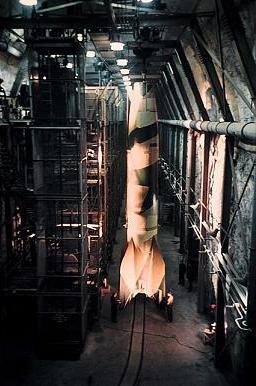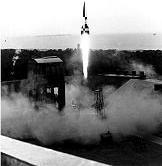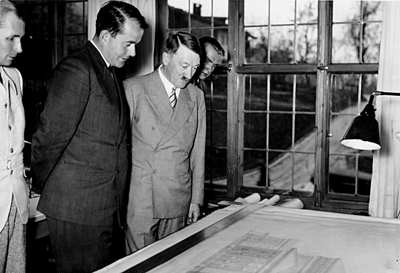Historical Background
The development of the V–2 missile flowed from the core ideals of the Nazi dictatorship in Germany, including the quest for military domination and the ruthless exploitation of forced labor. The German Army first commissioned Wernher von Braun to develop liquid-fuel rockets for military purposes in late 1932, two months before the Nazis came to power.
In 1936, the Army, as part of the Nazi government’s military expansion, began a secret program to develop ballistic missiles at Peenemünde on the Baltic Sea coast, a program that took on magnified importance when World War II began in 1939. The primary task of the engineers was to develop the A-4 ballistic missile, renamed in 1944 the V–2 vengeance weapon, a wonder weapon that Germany hoped would win the war.
The system of exploiting slave labor to assemble missiles began in 1943. It expanded dramatically after the August 1943 bombings of Peenemünde by the British Royal Air Force. The widespread destruction led the Nazi leadership and the missile staff to move underground and use forced labor. The chosen site was a mine/fuel depot near the town of Nordhausen in Thüringen. Slave laborers from the Buchenwald concentration camp came to extend the tunnels for an underground V–2 factory called Mittelwerk. The new concentration camp outside the tunnels was code named Dora and was later renamed Mittelbau. More than 60,000 prisoners were interred at Dora. Some of them built 6000 V–2 rockets between August 1943 and April 1945. They experienced squalid housing, starvation diets, and draconian discipline with frequent executions.
In April and May 1945, many of the engineers surrendered to the United States, while most of the remaining Dora prisoners endured brutal death marches. The United States Army liberated Mittelbau-Dora on April 11, 1945. Over 20,000 slave laborers died in the Mittelbau-Dora camp system.
The Nazi Regime, the SS, and Slave Labor
- Overview of the Nazi Dictatorship, from “Holocaust Encyclopedia&rdquo published by the United States Holocaust Memorial Museum
- Overview of Nazi Concentration Camp System, from “Holocaust Encyclopedia”
- In-Depth Information on Nazi Concentration Camp System, from “Holocaust Encyclopedia”
- Overview of Forced Labor in the Third Reich, from “Holocaust Encyclopedia”
- In-Depth Information on Forced Labor in the Third Reich, Including Use of Slave Labor in German Armaments Industry between 1942 and 1945, from “Holocaust Encyclopedia”
- Symposium on Nazi Slave Labor at the United States Holocaust Memorial Museum
- Overview of the SS in the Third Reich, from “Holocaust Encyclopedia”
- The SS and Nazi Policy, from “Holocaust Encyclopedia”
- The SS and the Concentration Camp System, from “Holocaust Encyclopedia”
Peenemünde and V–2 Rocketry
- Extensive Website with Historical, Biographical, and Technical Information and Multimedia on V–2 Rocketry and Peenemünde
- Information on Peenemünde and Operation Crossbow
- Technical Data on the Development of the V–2, prepared by Marshall Space Flight Center Historical Office in 1965
- Video footage of V2 Starts
- Video of V2 Rocket Facility including footage of Wernher von Braun
Mittelbau-Dora
- Historical Overview by Historian Dr. Michael Neufeld, from “Holocaust Encyclopedia” (See also links to Mittelbau: First Phase, Mittelbau: Conditions, Mittelbau: Last Phase, Mittelbau: Aftermath and Trials)
- Chronology of Key Events on United States Holocaust Memorial Museum Website
- Historical Overview at the Buchenwald and Mittelbau-Dora Memorials Foundation Website (Click on “Mittelbau-Dora Concentration Camp Memorial,” and then Click on “History”)
- Maps and Images of Mittelbau-Dora Outdoor Facilities (Click on “Mittelbau-Dora Concentration Camp Memorial,” and then Click on “Outdoor Facilities”)
- Detailed Information on Mittelwerk/Dora
- Overview of Mittelbau-Dora at La Coupole History and Remembrance Center Website
- German Television Documentary, “Hitlers Raketentunnel” (in German)
- Historical Overlays of Mittelbau-Dora Site at Google Earth




